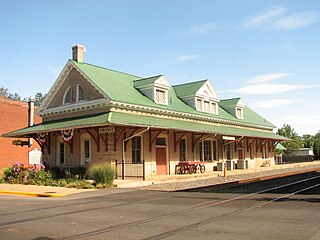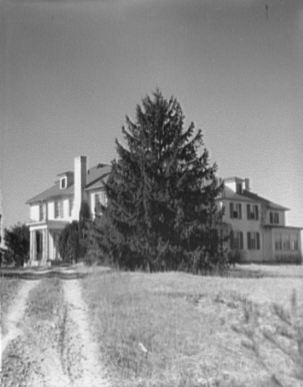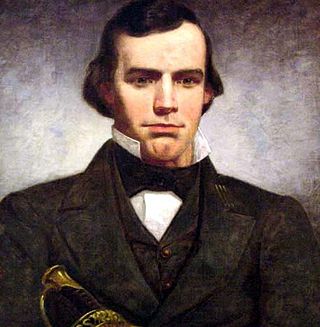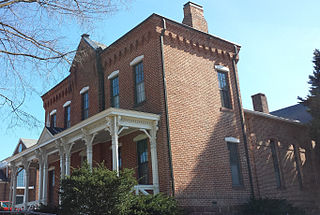
Fairfax, Virginia, formally the City of Fairfax, is an independent city in the Commonwealth of Virginia in the United States. As of the 2020 census, the population was 24,146. It is the county seat of Fairfax County, Virginia.

Arlington County is a county in the U.S. state of Virginia. The county is located in Northern Virginia on the southwestern bank of the Potomac River directly across from Washington, D.C. The county is coextensive with the U.S. Census Bureau's census-designated place of Arlington. Arlington County is the second-largest city in the Washington metropolitan area, although it does not have the legal designation of an independent city or incorporated town under Virginia state law.

Orange is a town and the county seat of Orange County, Virginia, United States. The population was 5,062 at the 2020 census, representing a 7.2% increase since the 2010 census. Orange is 28 miles (45 km) northeast of Charlottesville, 88 miles (142 km) southwest of Washington, D.C., and 4 miles (6 km) east of Founding Father and fourth U.S. president James Madison's plantation of Montpelier.

Brentsville is an unincorporated community village in Prince William County, Virginia, United States.

Christ Church is an Episcopal church located at 118 North Washington Street, with an entrance at 141 North Columbus Street, in Alexandria, Virginia. Constructed as the main church in the Church of England's Fairfax Parish, the building was designed by Col. James Wren, a descendant of Sir Christopher Wren.

Mount Eagle was a plantation home built by Bryan Fairfax, 8th Lord Fairfax of Cameron in 1789–90, south of Hunting Creek and Alexandria in Fairfax County, Virginia. It was demolished in 1968; the Huntington Metro Station and several condominium complexes were built on the property.
Charles Simms (1755–1819) was a Virginia lawyer, Revolutionary War officer and politician. A friend of George Washington, Simms thrice represented Fairfax County, Virginia, in the Virginia House of Delegates as well as at the Virginia Ratification Convention of 1788, and also served as mayor of Alexandria during the War of 1812.

The Lancaster Court House Historic District is a national historic district consisting of 25 structures, including one monument, located in Lancaster, Virginia, Lancaster County, Virginia. Four of the buildings make up the Mary Ball Washington Museum and Library, founded in 1958, whose purpose is to preserve and interpret the history of Lancaster County, Virginia.

Minor's Hill is a geographic eminence located in the western tip of Arlington County, Virginia. Its summit rises to 459 feet above sea level which makes it the highest point in the county. The hill is named after a man named George Minor who lived there at the time of the American Revolutionary War.
Falls Church, an independent city in Virginia, United States, takes its name from The Falls Church, an 18th-century parish of the Church of England. Falls Church gained township status within Fairfax County in 1875. In 1948, it was incorporated as the City of Falls Church, an independent city with county-level governance status.
Hope Park was an 18th and 19th-century plantation in Fairfax County in the U.S. state of Virginia, where Dr. David Stuart (1753–1814), an old friend of and correspondent with George Washington lived with his wife, Eleanor Calvert Custis (1758–1811), and family. It was approximately 5 miles (8.0 km) southwest of Fairfax Court House.

Historic Blenheim is a c. 1859 brick farm house designed in the Greek Revival style and located in City of Fairfax, Virginia. During the American Civil War, Union soldiers were often encamped on the grounds surrounding the house and utilized it as part of a reserve hospital system. As a result, more than 115 of these soldiers inscribed words and pictures on the first and second floor walls, as well as the attic of the house. Blenheim was added to the National Register of Historic Places in 2001.

John Quincy Marr was a Virginia militia company captain and the first Confederate soldier killed by a Union soldier in combat during the American Civil War. Marr was killed at the Battle of Fairfax Court House, Virginia on June 1, 1861. Previously one of Fauquier County's two delegates to the Virginia Secession Convention of 1861, Marr initially opposed his state's secession from the Union but ultimately supported secession, as did voters shortly before his fatal skirmish.

The Battle of Fairfax Court House was the first land engagement of the American Civil War with fatal casualties. On June 1, 1861, a Union scouting party clashed with the local militia in the village of Fairfax, Virginia, resulting in the first deaths in action, and the first wounding of a field-grade officer.

King and Queen Courthouse Green Historic District is a national historic district located at King and Queen Court House, near Shacklefords, King and Queen County, Virginia. It encompasses eight contributing buildings, seven contributing structures, and two contributing objects in the county seat of King and Queen County. The district includes a small courthouse compound with a courthouse, clerk's office, and county jail, a granite monument and brick wall, a hotel / tavern building, a school, a specialty store building, and a residence on the site of another hotel and tavern.

The Old Fairfax County Jail was built in 1885, behind the Fairfax County Court House. It was added to the National Register of Historic Places in 1981, expanding the previously listed Fairfax County Court House. It is located in the City of Fairfax Historic District.
Job Hawxhurst was a nineteenth-century American Quaker from New York who moved to Fairfax County, where he and his elder brother John Hawxhurst farmed and operated a grist mill beginning in 1846. As Union men, they fled Virginia temporarily as the American Civil War began in 1861, but returned to Fairfax in early 1862 and led their communities for decades. Job Hawxhurst operated a general store in Fairfax City and was postmaster for three decades, as well as Fairfax County's delegate in the Virginia General Assembly for one term, and at various times Clerk of Court, Mayor of Fairfax City and member of the Fairfax County Board of Supervisors. John Hawxhurst and his wife Jane lived in Alexandria, Virginia, after the war.

Fort Farnsworth is a former Union Army installation now located in the Huntington area of Fairfax County, Virginia. It was a timber and earthwork fortification constructed south of Alexandria, Virginia as part of the defenses of Washington, D.C. during the American Civil War. Nothing survives of the fort's structure as the Huntington Station of the Washington Metro occupies Fort Farnsworth's former hilltop site.

The Fairfax Station Railroad Museum (FSRM) is a depot museum located in the census-designated place of Fairfax Station in Fairfax County, Virginia. It is owned and operated by the Friends of the Fairfax Station, an all-volunteer, 501(c)(3) non-profit organization. The purpose of the Friends is to maintain the former station as a museum with a focus on local history, the significance of railroads in the region, and the role of the station during the American Civil War. It opened in April 1988.
























